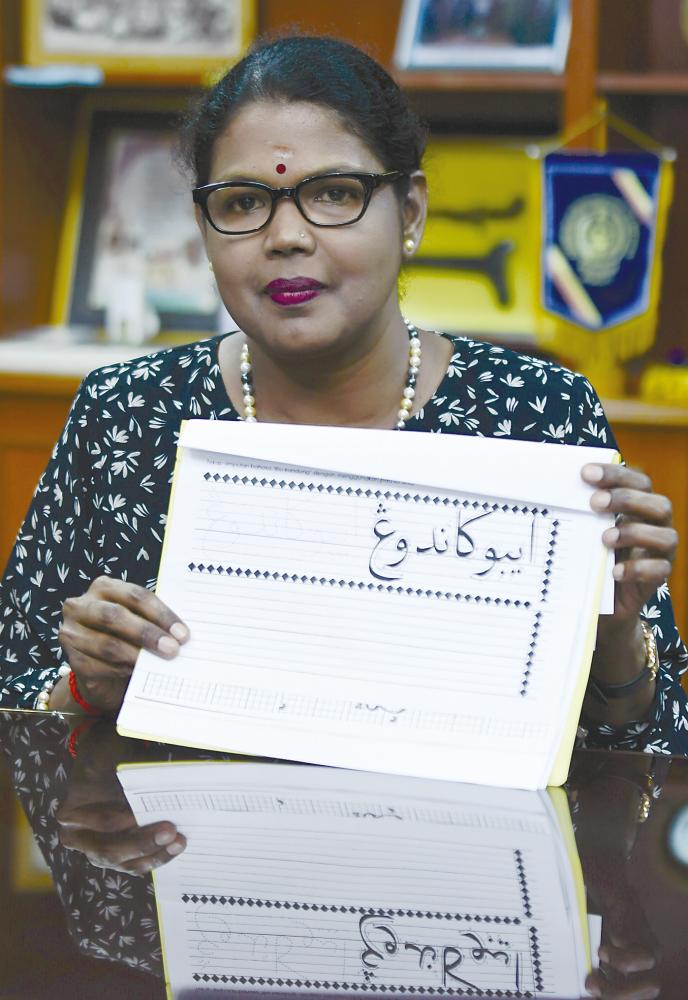THE debate on the teaching of jawi in vernacular schools has been ongoing for months. No long-term solution seems to be in sight, largely because the Ministry of Education and the Cabinet have not tried to evaluate the issue based on the real educational needs and best interest of the pupils. To this date, many pertinent questions and issues raised by various stakeholders, including this writer (Letter to theSun, Aug 14) have been largely evaded or even ignored. There are still ambiguities begging to be cleared. Many are still unaware that the initial seni khat has now evolved into jawi script, and they do not know the difference between the two.
This writer has even written recently to Bahagian Pembangunan Kurikulum (BPK) of MoE where she worked many years ago, to seek clarifications and secure more definitive answers, but response does not seem forthcoming. It is indeed befuddling and disenchanting why such a contentious policy initiated by the previous regime in or before 2017, is now so doggedly pursued by the new PH government, which is expected to bring about meaningful reform and progress.
The latest is that on Nov 28, the High Court of Penang ruled that the teaching of jawi script will be “allowed” in vernacular schools. As such, all quarters have been advised by a minister to “respect court’s decision”! However, I do hope this advice will not be misconstrued by various people to mean that henceforth, the MoE is “empowered” to implement the teaching of jawi in vernacular schools, without taking into serious consideration the real educational needs of pupils, or against the better judgment of all other stakeholders. What the court ruling means is that “schools can teach jawi”, it is not against the Federal Constitution, as argued or challenged by a political party.
All these exasperating arguments about the teaching of jawi in vernacular schools have brought to mind memory of my own experiences as a pupil at the Kok Min Chinese primary school in KL many decades ago.
(This school, housed in the Hokkien Association Building in Kuala Lumpur, no longer exists.) I remember my BM teacher then, a young amiable Malay man in his 20s, whom we fondly addressed as Cikgu Nor. (I think his full name is Nor Mohammed, and he lived in Gombak.) He used to wear a songkok to school on Fridays and he sometimes carried with him newspapers with what I then perceived as “funny script”.
One day, piqued by curiosity coupled by an inquisitive mind typical of a 10-year-old, I seized the opportunity to pop the question about this script at an opportune time during our BM lesson. As always, Cikgu Nor responded to the whole class with a brief and interesting account of what jawi script is. Some keen learners among us, impressed by its unique artistic form, were quick to follow up with a request to learn jawi. Guess what? Cikgu Nor told us sternly that he would teach it only if the whole class could pass the mid-term Standard Five BM test, including the weekly “ejaan” tests. Of course, he never got down to teaching us any jawi that year because many of my classmates failed in these tests. (I remember we started learning English and BM in Standard Three, but by Standard Five, many of my classmates were still struggling with the Roman alphabet in the English spelling and BM ejaan!) So, jawi was all but put aside or forgotten in Standard Six the following year, as we were all too busy preparing for the National Standard Six Examination.
Thus, I missed the chance to learn jawi in my primary school years, but I did learn all about what it is from Cikgu Nor, and this basic knowledge has stayed with me. More importantly, I remember that many of my classmates did pass the BM paper in that National Standard Six exam, with a handful, including myself, scoring A’s. For these achievements, we all owe our thanks to Cikgu Nor’s wisdom and hard work.
Of course, I do not begrudge Cikgu Nor for my missed opportunity in learning the jawi script. I could have learned it in later years, but I guess I never felt the need to do so. Like many of my peers, I preferred to focus on scoring A’s in what we deemed as important subjects .
In retrospect, I think Cikgu Nor had made a wise and right decision about not teaching us jawi. Being the conscientious and caring teacher that he was, he chose to focus on helping the majority of his charges master BM reading and writing skills in rumi, rather than teaching jawi to satisfy the curiosity of a small bunch of high-achievers. Wherever you are today, Cikgu Nor, I salute you for your wisdom to choose to teach with the best interest of your pupils at heart. I hope the MoE and the government can take a leaf from Cikgu Nor’s book.
Speaking of reform and progress, perhaps we should look East and learn something from China which has been so successful since its opening up only about 40 years ago. China is an old civilisation of more than 5,000 years. Its writing script has evolved through at least four or five different forms. However, for the last few centuries, the Chinese have been using and learning the modern script, which has also been further simplified over the past few decades. Are Chinese students today required to learn the four or five antiquated scripts in schools? No, perhaps only those who delve into ancient Chinese history, classic literature, anthropology or archaeology opt to do so, most probably in the tertiary education institutions. Over the last 40 years or so, the Chinese government has focused on real reform and progress in education and other fields to advance to where it is today, one of the world leaders in IT, robotics, etc. What is the moral of this story?
I fervently hope that all stakeholders involved in protecting the interest of vernacular school children will not be forced to acquiesce to an insidious policy that spells more hardship or presents more learning problems for our young charges. If and when that happens, many rakyat will certainly join me in a chorus of sigh, with disenchantment or even in despair: I cry for thee ... ye children of Malaysia”.
Dr Gan Siowck Lee is an academic. Comments: letters@thesundaily.com














